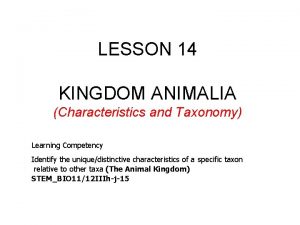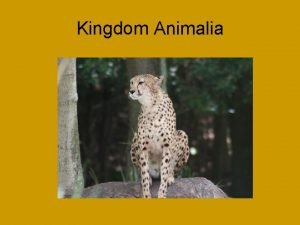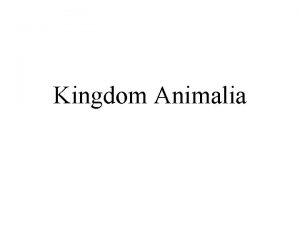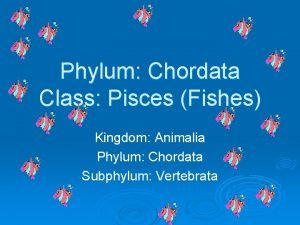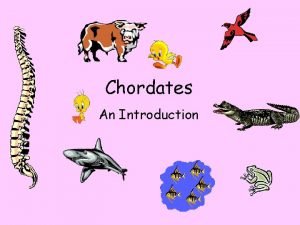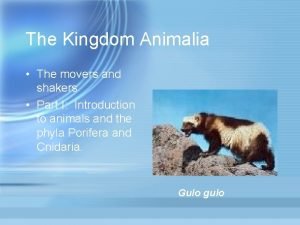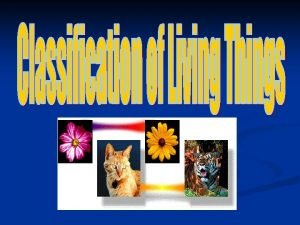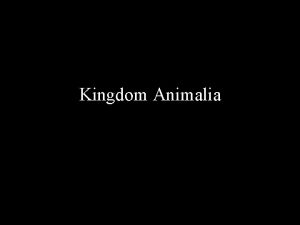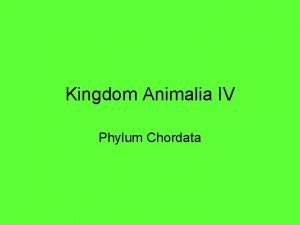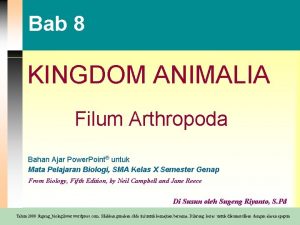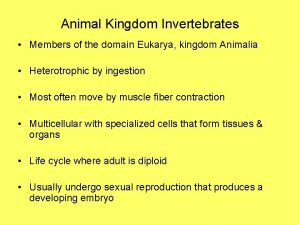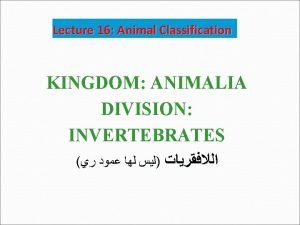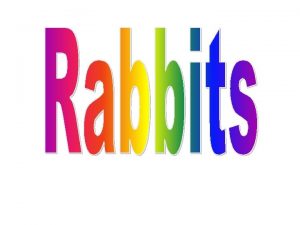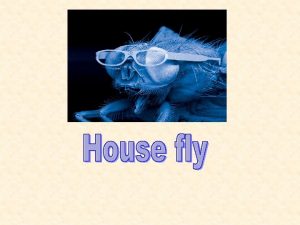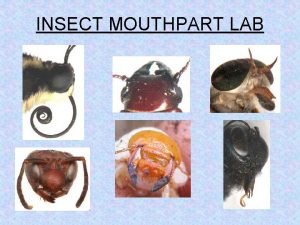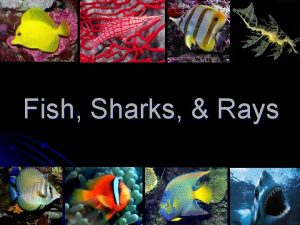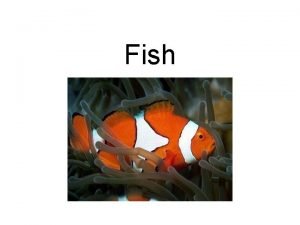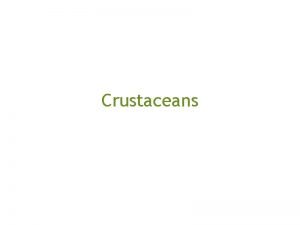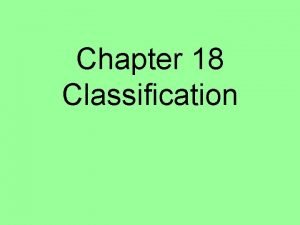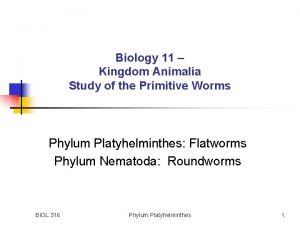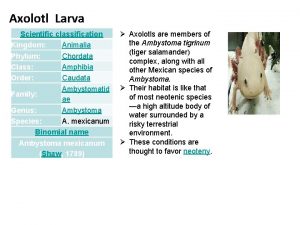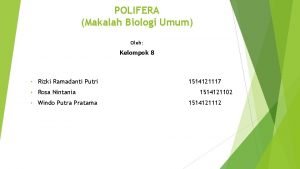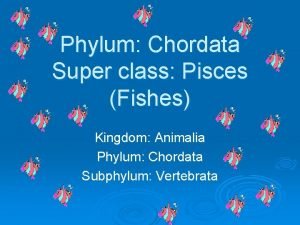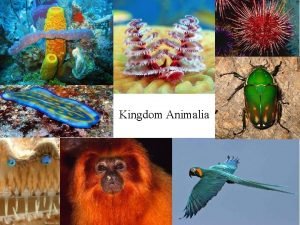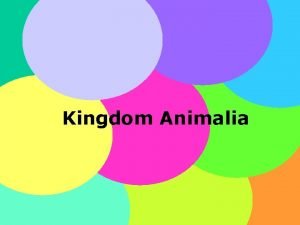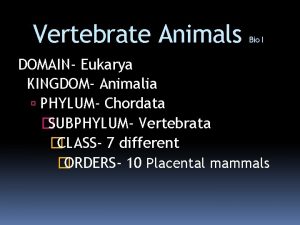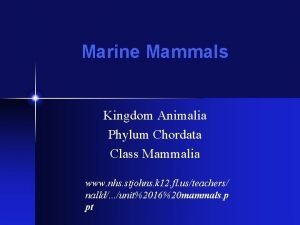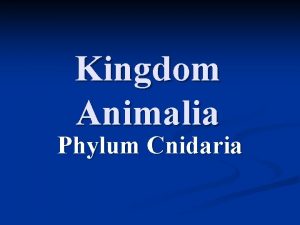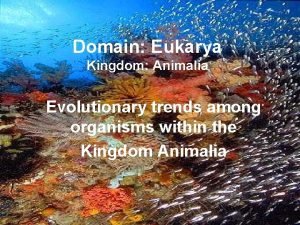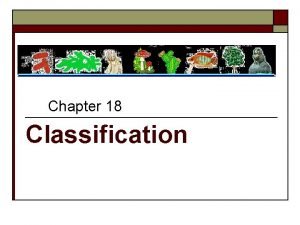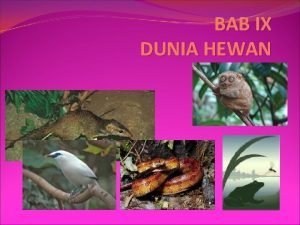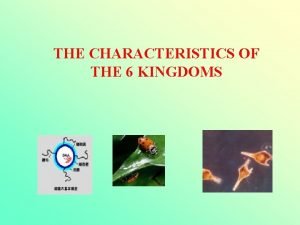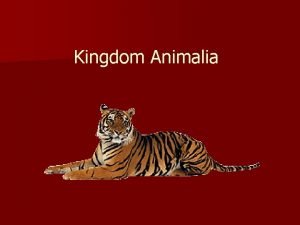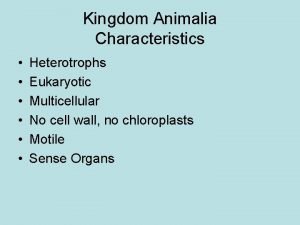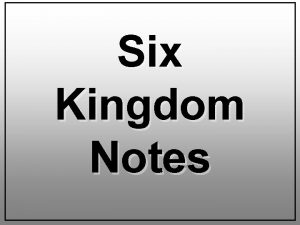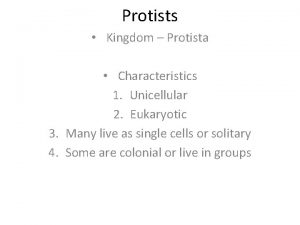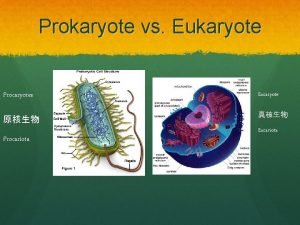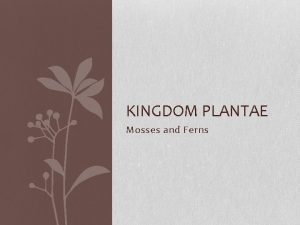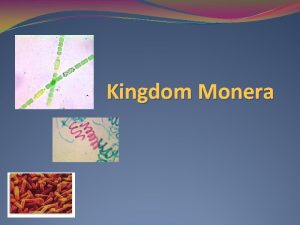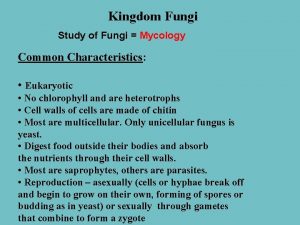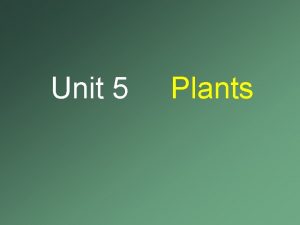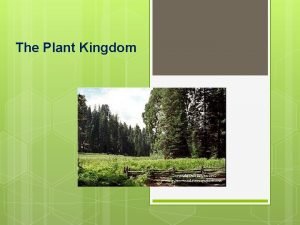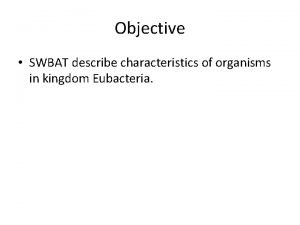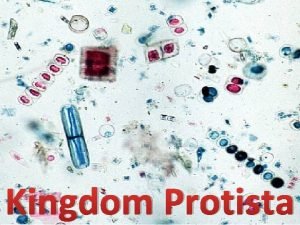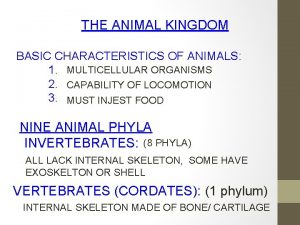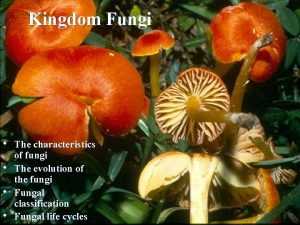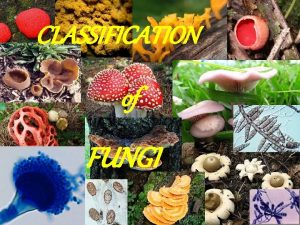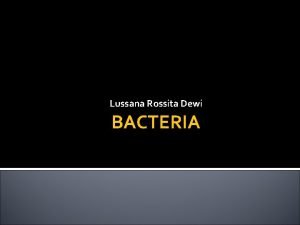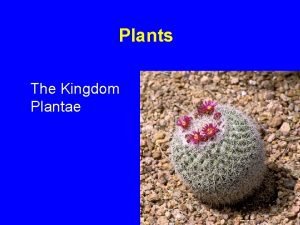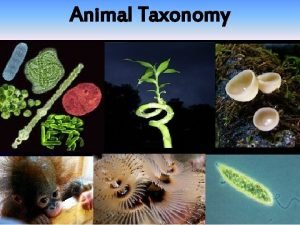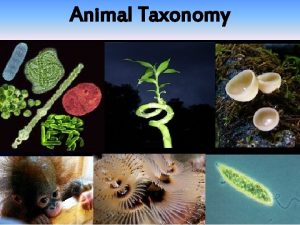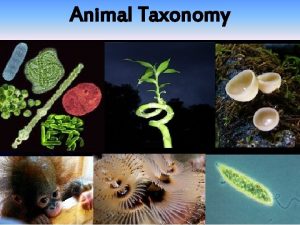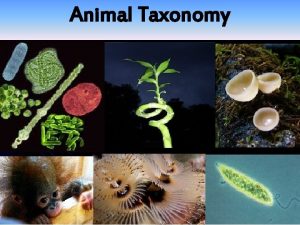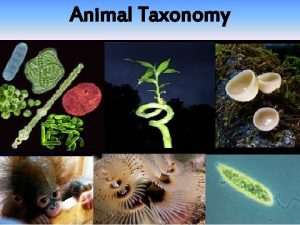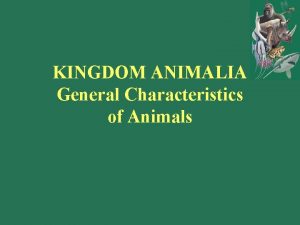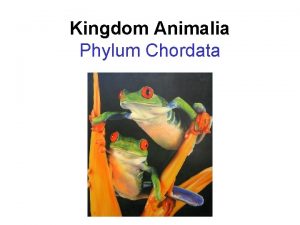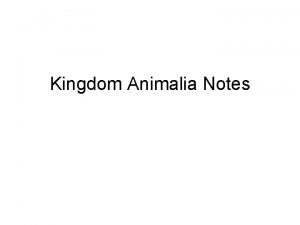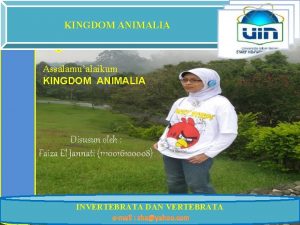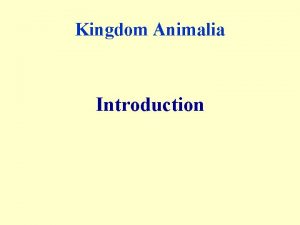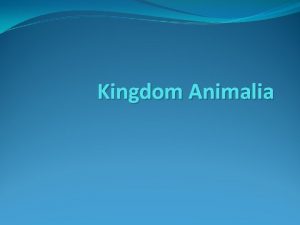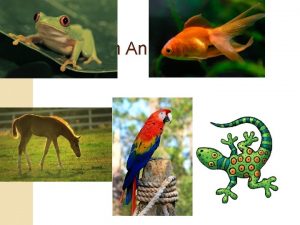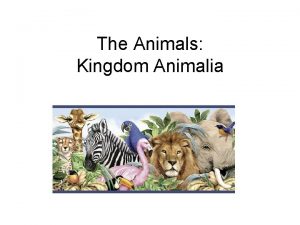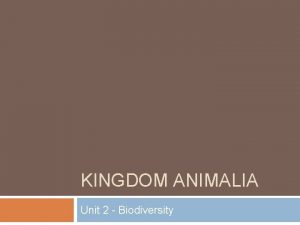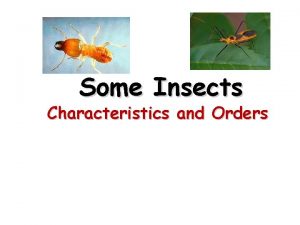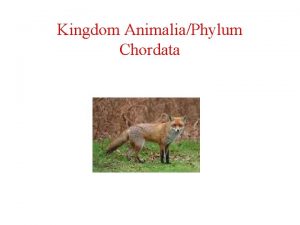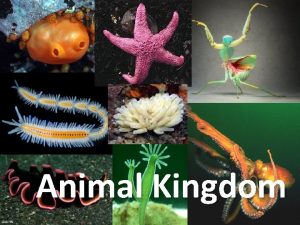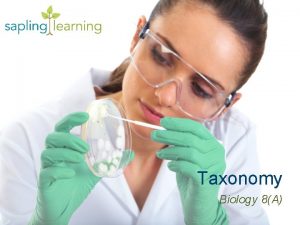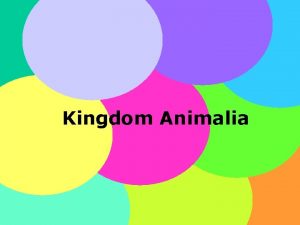LESSON 14 KINGDOM ANIMALIA Characteristics and Taxonomy Learning
















































































- Slides: 80

LESSON 14 KINGDOM ANIMALIA (Characteristics and Taxonomy) Learning Competency Identify the unique/distinctive characteristics of a specific taxon relative to other taxa (The Animal Kingdom) STEM_BIO 11/12 IIIh-j-15

Enhancement Video on the Animal Kingdom https: //www. youtube. com/results? search_qu ery=animal+kingdom Guide Questions: 1. What are the Characteristics of Animals that set apart from other living things 2. What are the Phylums or Divisions under Animal Kingdom 3. Give examples 4. What is your realization of the video on Animal Kingdom? (Evolution; Medical breakthrough; Mutation; Speciation)

Three Domains of Life

Kingdom Animalia • • Eukaryotic (Domain Eukaryota) Multi-cellular (unlike most Protists) Lack cell walls (unlike Plants and Fungi) Heterotrophic, by ingestion – Animals obtain their nourishment by ingesting other organisms (unlike Fungi)

Kingdom Animalia • Most animals are mobile • Sexual reproduction; haploid cells fuse directly to produce zygote, and no alternation of generations • Tissues – cells are organized into structurally functional tissues

Kingdom Animalia • Radial symmetry – body parts arranged around a central axis (simple) • Bilateral symmetry – body has a right and a left half that are mirror images of each other (advanced)

Kingdom Animalia • Evolution of a body cavity enabled the evolution of supporting organ systems and a means for distributing materials • The body cavity – a space surrounded by mesodermal tissue formed during development (Coelom) • Three germ layers: Ectoderm (outside), Mesoderm (middle), and Endoderm (inside)

Kingdom Animalia • Pseudocoelomates move nutrients and wastes through pseudocoel • Coelomates developed a circulatory system; blood carries oxygen, nutrients, carbon dioxide and wastes through (and out of) body

Kingdom Animalia • Taxonomy (Domain Eukaryotic, Kingdom Animalia, Phylum…. )

KINGDOM ANIMALIA 1. Phylum Porifera – Sponges 2. Phylum Cnidaria/Coelenterata – Hollow Bodied Animals (Jelly Fish) 3. Phylum Ctenophora – Comb Jellies 4. Phylum Platyhelminthes - Flatworm 5. Phylum Nematoda – Roundworm 6. Phylum Annelida – Segmented Worm 7. Phylum Mollusca – Mollusks (Shell) 8. Phylum Arthropoda – Joint legged animals 9. Phylum Echinodermata – Spiny Skinned 10. Phylum Chordata – with notochords (Lungs)

10. Phylum Chordata – with notochords (Lungs) 3 Sub Phylums: a. Sub-Phylum Urochordata (non vertebrates) b. Sub-Phylum Cephalochordata – notochord (non-vertebrates) c. Sub-Phylum Vertebrata – Vertebrates (Vertebral Columns)

c. Sub-Phylum Vertebrata – Vertebrates (Vertebral Columns) 6 Classes: 1. Class Chondricthyes – Cartilaginous fishes 2. Class Osteichthyes – bony fishes 3. Class Amphibia – salamanders and frogs 4. Class Reptilia – reptiles 5. Class Aves - birds 6. Class Mammalia - Mammals

6. Class Mammalia 3 Sub-Classes: 1. Prototheria – monotremes, platypus 2. Metatheria- Marsupial, kangaroo 3. Eutheria – Placentals

3. Eutheria – Placentals 8 Orders: 1. Carnivora – canine, dogs 2. Perissodactyla – horses 3. Artiodactyla –cows, pigs 4. Proboscoidea - elephants 5. Rodentia – rats, squirrel 6. Chiroptera – bats 7. Insectivora –shrews and moles 8. Primata- primates

8. Primata- primates 2 sub-Orders 1. Prosimians 3 Superfamilies: Lemurodea, Lorisoidea, Tarsioidea 2. Anthropods 3 Superfamilies 1. Ceboidea – New world monkeys 2. Cercopithecoidea – Old world monkeys 3. Hominoidea – Hominids – apes and humans

3. Hominoidea – Hominids – apes and humans 2 families: Ponginidae and Hominidae

1. Phylum Porifera (Sponges) • The simplest of animals • No nervous, digestive, or circulatory systems • Sessile • Lack germ layers • No defined symmetry

Phylum Porifera (sponges) • • Asymmetrical Pores—filter feeders Not motile (sessile) Provide habitat for other animals • Eaten by starfish and some fish • Most primitive animal

2. Phylum Cnidaria • Nematocysts – stinging cells • Radial symmetry • “Jellyfish”, Corals, Sea anemones

Phylum Cnidaria (jellyfish, sea anemones, coral) • Digestive cavity called a coelenteron • Radial symmetry • Predators-feed on crustaceans • Corals provide important habitat for fish • Coral used for decoration and threatened by pollution • All have stinging cells

3. Phylum Ctenophora (Comb jellies) • Colloblasts – sticky cells • Strictly marine • Largely bioluminescent

4. Phylum Platyhelminthes (Flatworms) • No body cavity • Half of all flatworms are parasitic (flukes, tapeworms, etc)

Phylum Platyhelminthes (planarians, tapeworms, flukes) • Bilateral symmetry • Cephalization- head and brain • Acoelomate- no body cavity • Incomplete digestive system (one opening) • Some are parasites in digestive tract • In early 1900’s models ate them to be thin— YUCK!

5. Phylum Nematoda (Round worms) • Pseudocoelomates • Can be free-living or parasitic http: //www. attra. org/images/nematode. jpg

Phylum Nematoda (roundworms) • Also called nematodes • Complete digestive system-separate mouth and anus (2 openings) • Pseudocoelomate • Decomposers, predators (bacteria, inverts) • Eaten by insects, mice • Beneficial to garden by eating insects

6. Phylum Annelida (Segmented worms) • Coelomates • Oligochaetes (earthworms) and Polychaetes (bristle worms)

Phylum Annelida (segmented worms) • i. e. earthworms, leeches • True coelom • Sensitive to vibrations on ground-rain • Prey for robins, shrews, jays, snakes • Leeches have cornified knobs to break skin, anticoagulant and anesthetic

7. Phylum Mollusca • Mantle – secretes shell; forms siphon and external flaps • Bivalves (clams, mussels, etc), Snails, Squid, Octopus, Sea Slugs http: //www. flickr. com/photos/ccahua/109008198/ http: //www. flickr. com/photos/sabinche/424078457/

Phylum Mollusca (shelled…sometimes) • i. e. snails, slugs, clams, mussels, scallops, oysters, octopus and squid • Variety in form • Giant squid = sea serpent • Introduction of garden snails

8. Phylum Arthropoda (jointed legged animals) • i. e. insects, spiders and scorpions, shellfish (crustaceans), centipedes (1 pr legs per segment), millipedes (2 pr) • Exoskeleton • Metamorphosis • Pheromones • Molting

Phylum Arthropoda • “Jointed foot”; jointed limbs, rigid cuticle/exoskeleton • 3 sub-phylums: Insecta, Arachnida, Crustacea, and others – VERY SUCCESSFUL! http: //www. flickr. com/photos/j-a-x/98046000/

9. Phylum Echinodermata • Strictly marine • “Spiny skin” • Includes sea stars, sea urchins, brittle stars

Phylum Echinodermata (spiny-skinned) • i. e. sea stars = starfish, sea urchins • Water vascular system • Tube feet • Important predators

10. Phylum Chordata • Includes all vertebrates (Subphylum Vertebrata) • All have (at one stage of their life cycle) – A notochord – a flexible rod; “backbone” – A hollow, dorsal nerve cord; develops into spinal cord and brain – Pharyngeal slits* – filtering apparatus for feeding – An endostyle* – longitudinal ciliated groove in pharynx, produces mucus to capture food particles – A post-anal tail* *only present during embryonic stage in advanced vertebrates

All Chordates have all four of these characteristics at some time in their lives


Phylum Chordata Subphylum Urochordata tunicates Subphylum Cephalochordata lancets Subphylum Vertebrata Agnathans Fish Sharks tetrapods

Early Chordate ancestor may have given rise to 1 st vertebrate Pikaia Burgess Shale Fauna Cambrian 540 -500 mya

General Features Shared by Chordates: 1. Eukaryote 2. Multicellular 3. Bilateral- deuterstomes 4. Heterotrophic

Phylum Chordata Subphylum Urochordata - Tunicates Class Ascidiacea - Sea Squirts Solitary e. g. Styela montereyensis Colonial - in groups but with own tunic Compound Colonial - colonial with shared tunic Class Thaliacea - Salps (free swimming), planktonic Class Larvacea - Gelatinous house, planktonic

Subphylum Urochordata tunicate

Subphylum Urochordata = tunicate Tunicate - also called 'sea squirt' • notochord is confined to the tail • notochord is lost during metamorphosis into sessile adult • possess pharyngeal slits • Repro- sexual (hermaphroditic) & asexual (budding)

Class Larvacea - planktonic Oikopleura

Class Larvacea - Gelatinous house, planktonic Jelly-like house Oikopleura Marine snow

Class Thaliacea - Salps (free swimming), planktonic Pyrosoma- bioluminescent Colonial salp

Class Ascidiacea - Sea Squirts

Subphylum Cephalochordata lancet • • • Strictly marine Live buried in sand with head sticking out Filter feeders

Lancet Anatomy

Subphylum Vertebrata Class Chondrichthyes Sharks, skates, rays, chimera

Chondrichthyes (cartilagenous fishes) • • • Heterocercal tail Two dorsal fins Paired pectorals 5 -7 gill slits ureoosmotic


Osteichthyes (bony fishes) • • Swim bladder Operculum (gill cover) Homocercal tail Scales of bony origin – Smooth cycloid – Spiny ctenoid

Spinal cord Swim bladder Dorsal fin Brain Adipose fin (characteristic of trout) Nostril Anal fin Cut edge of operculum Liver Gills Heart Kidney Stomach Intestine Gonad Lateral line Anus Pelvic fin Urinary bladder Caudal fin

Class Amphibia Characteristics • • • Cold blooded Returns to water to breed Metamorphosis Some toxic Estivation-dry and hot Hibernation- cold 3, 500 species

Class Amphibia salamander Poison arrow frog newt Rana cancrivora Mudpuppy (salamander) Coqui

Class Reptilia Characteristics • • • Cold blooded Have scales Amniotic egg Dry skin 3 chambered heart (except crocks) 6, 500 species

Class Reptilia Marine iguana Saltwater crocodile Marine turtle Sea snake

Class Aves Characteristics • • • Warm blooded Feathers and wings Hollow bones Horny bill Lungs have air sacks Hard egg shell

Class Aves

Class Mammalia Characteristics • • Warm blooded Have fur or hair Suckle young 3 middle ear bones

Class Mammalia Subclasses • Protheria- echidna & platypus • Metatheria- marsupial • Eutheria- true mammals

Class - Mammalia ~4500 species in 19 orders Characteristics • hairy animals with glands that produce milk • maintain constant body temp. • most develop in the uterus where they are nourished by a placenta • limbs are under the body, directed downwards • fully mobile jaw and socket teeth

Origins • probably arose from therapsids (200 mya) which are mammal-like reptiles

• survival was probably enhanced by carrying embryos within the body, bearing live young, and the constant food supply (milk) • by the end of the Mesozoic era (65 mya) mammals diverged from the original line to three “groups” (probably sub-classes) -Monotremes, Marsupials, and Placentals

1. Monotremes Subclass: Protothereia, Order: Monotremata • egg (leathery)-laying mammals • have a sense of electroreception to locate their prey • only five species exist, the duck-billed platypus and four sp. of spiny anteaters (Echidna) Ornithorhynchidae • single hole that serves the urinary tract, anus, and reproductive tract (Ornithorhynchus anatinus)

2. Marsupials Marsupialia Subclass – Theria or Metatheria Supercohort- • the pouched animals- 272 species. • short gestation time is due to having a yolktype placenta in the mother marsupial • young are typically born in a practically embryonic state (2 cm). • Ex. Opossum, koala, wallaby, wombat, kangaroo, and Tasmanian Devil. .

3. Placentals (subclass Eutheria) • nourished in the uterus through a specialized embryonic organ attached to the uterus wall called the placenta allowing longer gestation times. • 4000+ species. whales, bats, elephants, armadillos, dogs, sheep, cattle, and humans. .

Order – Primates Characteristics and origins • 233 living species placed in 13 families • most have long arms, prehensile (grasping) tail and hands with fingernails • stereoscopic vision with eyes in front of head • brain adapted for learning • probably arose about 65 mya • early primates were more like rodents that lived in trees

THE PRIMATES © 2016 Paul Billiet ODWS

Primate characteristics • • • Arborial Grasping hands Finger nails & finger pads with ridges Binocular vision Diurnal Colour vision Large brain High degree of parental care Long childhood © 2016 Paul Billiet ODWS

The Prosimians Ring-tailed lemur (Lemur catta) © 2016 Paul Billiet ODWS

The Prosimians • • • Muzzel Immobile upper lip Developed sense of smell Ears can orientate Evolved from about 63 Ma © 2016 Paul Billiet ODWS

The Old World Monkeys © 2016 Paul Billiet ODWS Rhesus macaques (Macaca mulatta)

The Old World Monkeys • Narrow nose • Tail (when present) never prehensile • Mostly diurnal © 2016 Paul Billiet ODWS

The New World Monkeys © 2016 Paul Billiet ODWS Howler monkey (Alouatta sp. )

The New World Monkeys • Split from the old world monkeys about 40 Ma • Flat-nosed • More premolars • Long tails, some prehensile © 2016 Paul Billiet ODWS

The Apes Gorilla gorilla Orangutan (Pongo pygmaeus) Gibbon (Hylobates lar) Chimpanzee (Pan troglodytes) © JGI © 2016 Paul Billiet ODWS

Application Human classification/taxa • • Animalia Kingdom: Animalia Phylum: Chordata Subphylum: Vertebrata Class: Mammalia Subclass: Theria Infraclass: Eutheria Primate Order: Primates Suborder: Anthropoidea Hominidae Superfamily: Hominoide Family: Homo Hominidae Genus: Homo sapiens Species: sapien

Application & Reflection: (5 mins) 1. What is the Importance of Taxonomy in Science? 2. How do you think organisms were clustered and what ere their bases? 3. How do you apply the lesson on animal kingdom to life?

Assignment: Bring bond papers and coloring pens for the animal kingdom sketching next meeting (1 organism per phylum)
 Larvacea
Larvacea Characteristics of animalia
Characteristics of animalia Characteristics of animals
Characteristics of animals Old kingdom middle kingdom new kingdom
Old kingdom middle kingdom new kingdom Nnn ruled
Nnn ruled Roman empire
Roman empire Mentohotep
Mentohotep Kendall taxonomy
Kendall taxonomy Kingdom pisces
Kingdom pisces Animalia kingdom chordates and vertebrates
Animalia kingdom chordates and vertebrates Nine phyla of kingdom animalia
Nine phyla of kingdom animalia Kingdom animalia cell structure
Kingdom animalia cell structure Plantae cladogram
Plantae cladogram Lackcell
Lackcell Monera protista fungi plantae animalia
Monera protista fungi plantae animalia Kingdom animalia phylum chordata
Kingdom animalia phylum chordata Arthropoda
Arthropoda Which are all members of the domain eukarya
Which are all members of the domain eukarya Food vacuole eukaryotic or prokaryotic
Food vacuole eukaryotic or prokaryotic Kingdom animalia
Kingdom animalia Family leporidae kingdom
Family leporidae kingdom Diptera
Diptera Domain of animalia
Domain of animalia Insects kingdom
Insects kingdom Animalia kingdom
Animalia kingdom Shark skates and rays are also called
Shark skates and rays are also called Phylum fish
Phylum fish Kingdom animalia phylum arthropoda
Kingdom animalia phylum arthropoda Kingdom animalia contains 350 000 species of what
Kingdom animalia contains 350 000 species of what Characteristics of platyhelminthes
Characteristics of platyhelminthes Axolotl age size chart
Axolotl age size chart Cladogram of animal kingdom
Cladogram of animal kingdom Manfaat calcarea
Manfaat calcarea Coelenterata digestive system
Coelenterata digestive system Kingdom pisces
Kingdom pisces Kingdom animalia organisms
Kingdom animalia organisms Ciri animalia
Ciri animalia All vertebrate animals are in domain
All vertebrate animals are in domain Kingdom animalia phylum chordata
Kingdom animalia phylum chordata Kingdom animalia phylum cnidaria
Kingdom animalia phylum cnidaria Domain eukarya kingdom animalia
Domain eukarya kingdom animalia Finding order in diversity
Finding order in diversity Daur hidup fasciola hepatica
Daur hidup fasciola hepatica Classification of animal kingdom
Classification of animal kingdom Animal kingdom taxonomy chart
Animal kingdom taxonomy chart Cool protists
Cool protists Share
Share Eukarya plantae
Eukarya plantae The odds and ends kingdom
The odds and ends kingdom Characteristics of a multicellular organism
Characteristics of a multicellular organism Kingdom
Kingdom Cuadro comparativo e-learning y b-learning
Cuadro comparativo e-learning y b-learning Psychomotor domain verbs
Psychomotor domain verbs Bloom's taxonomy lesson plans examples
Bloom's taxonomy lesson plans examples Chapter 14 lesson 2 north and south
Chapter 14 lesson 2 north and south Little kingdom childcare
Little kingdom childcare Lesson 2 the israelite kingdom answer key
Lesson 2 the israelite kingdom answer key Kingdom characteristics chart
Kingdom characteristics chart Cilophora
Cilophora Procaryote vs eucaryote
Procaryote vs eucaryote Unique characteristics of bacteria
Unique characteristics of bacteria Domain bacteria kingdoms
Domain bacteria kingdoms Are protists eukaryotic
Are protists eukaryotic Plantae kingdom characteristics
Plantae kingdom characteristics Character of plantae
Character of plantae Monera characteristics
Monera characteristics 10 characteristics of fungi
10 characteristics of fungi Fungus characteristics
Fungus characteristics 5 characteristics of plants.
5 characteristics of plants. Plantae characteristics
Plantae characteristics Basidiomycota sexual reproductive structures
Basidiomycota sexual reproductive structures Plant kingdom characteristics
Plant kingdom characteristics Kingdom eubacteria characteristics
Kingdom eubacteria characteristics Nutrition in protists
Nutrition in protists Basic characteristics of animals
Basic characteristics of animals General characteristics of fungi
General characteristics of fungi Ainsworth classification of fungi
Ainsworth classification of fungi Characteristics of kingdom protista
Characteristics of kingdom protista Distinguishing characteristics of plantae
Distinguishing characteristics of plantae Bad rossita
Bad rossita Nonvascular plants
Nonvascular plants
